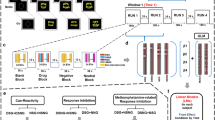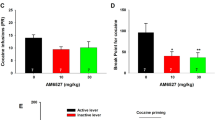Abstract
Impulsive action, the failure to withhold an inappropriate response, is treated clinically with dopamine agonists such as amphetamine. Despite the therapeutic efficacy, these drugs have inconsistent effects on impulsive action in rodents, causing improvements or disruptions in different tasks. Thus, we hypothesized that amphetamine is producing an effect by altering distinct cognitive processes in each task. To test this idea, we used the response inhibition (RI) task and trained rats to withhold responding for sucrose until a signal is presented. We then varied the duration that subjects were required to inhibit responding (short=4 s; long=60 s; or variable=1–60 s) and examined whether this influenced the pattern of premature responses. We also tested the effects of amphetamine (0.0, 0.125, 0.25, 0.5, and 1.0 mg/kg) on each task variant. The probability of premature responding varied across the premature interval with a unique pattern of time-dependent errors emerging in each condition. Amphetamine also had distinct effects on each version: the drug promoted premature responding when subjects expected a consistent delay, regardless of its duration, but reduced premature responding when the delay was unpredictable. We propose that the ability to inhibit a motor response is controlled by a different combination of cognitive processes in the three task conditions. These include timing, conditioned avoidance, and attention, which then interact with amphetamine to increase or decrease impulsive action. The effect of amphetamine on impulsive action, therefore, is not universal, but depends on the subject's experience and expectation of the task demands.
Similar content being viewed by others
Log in or create a free account to read this content
Gain free access to this article, as well as selected content from this journal and more on nature.com
or
References
Agmo A, Belzung C, Rodriguez C (1997a). A rat model of distractibility: effects of drugs modifying dopaminergic, noradrenergic and GABAergic neurotransmission. J Neural Transm 104: 11–29.
Agmo A, Medrano A, Garrido N, Alonso P (1997b). GABAergic drugs inhibit amphetamine-induced distractibility in the rat. Pharmacol Biochem Behav 58: 119–126.
Balci F, Ludvig EA, Gibson JM, Allen BD, Frank KM, Kapustinski BJ et al (2008). Pharmacological manipulations of interval timing using the peak procedure in male C3H mice. Psychopharmacology (Berl) 201: 67–80.
Befort K, Mahoney MK, Chow C, Hayton SJ, Kieffer BL, Olmstead MC (2011). Effects of delta opioid receptors activation on a response inhibition task in rats. Psychopharmacology (Berl) 214: 967–976.
Belin D, Mar AC, Dalley JW, Robbins TW, Everitt BJ (2008). High impulsivity predicts the switch to compulsive cocaine-taking. Science 320: 1352–1355.
Bizarro L, Patel S, Murtagh C, Stolerman IP (2004). Differential effects of psychomotor stimulants on attentional performance in rats: nicotine, amphetamine, caffeine and methylphenidate. Behav Pharmacol 15: 195–206.
Bizot JC (1997). Effects of psychoactive drugs on temporal discrimination in rats. Behav Pharmacol 8: 293–308.
Bizot JC (1998). Effects of various drugs including organophosphorus compounds (OPC) and therapeutic compounds against OPC on DRL responding. Pharmacol Biochem Behav 59: 1069–1080.
Cardinal RN, Robbins TW, Everitt BJ (2000). The effects of d-amphetamine, chlordiazepoxide, alpha-flupenthixol and behavioural manipulations on choice of signalled and unsignalled delayed reinforcement in rats. Psychopharmacology 152: 362–375.
Carey RJ, Kritkausky RP (1972). Absence of a response-rate-dependent effect of d-amphetamine on a DRL schedule when reinforcement is signaled. Psychon Sci 26: 285–286.
Cole BJ, Robbins TW (1987). Amphetamine impairs the discriminative performance of rats with dorsal noradrenergic bundle lesions on a 5-choice serial reaction time task: new evidence for central dopaminergic-noradrenergic interactions. Psychopharmacology (Berl) 91: 458–466.
Dalley JW, Everitt BJ, Robbins TW (2011). Impulsivity, compulsivity, and top-down cognitive control. Neuron 69: 680–694.
Dalley JW, Fryer TD, Brichard L, Robinson ES, Theobald DE, Laane K et al (2007). Nucleus accumbens D2/3 receptors predict trait impulsivity and cocaine reinforcement. Science 315: 1267–1270.
Eagle DM, Robbins TW (2003). Inhibitory control in rats performing a stop-signal reaction-time task: effects of lesions of the medial striatum and d-amphetamine. Behav Neurosci 117: 1302–1317.
Eckerman DA, Segbefia D, Manning S, Breese GS (1987). Effects of methylphenidate and d-amphetamine on timing in the rat. Pharmacol Biochem Behav 27: 513–515.
Feola TW, de Wit H, Richards JB (2000). Effects of d-amphetamine and alcohol on a measure of behavioral inhibition in rats. Behav Neurosci 114: 838–848.
Fester CB, Skinner BF (1957). Schedules of Reinforcement. Appleton-Century-Crofts: New York.
Fletcher PJ, Rizos Z, Noble K, Higgins GA (2011). Impulsive action induced by amphetamine, cocaine and MK801 is reduced by 5-HT(2C) receptor stimulation and 5-HT(2A) receptor blockage. Neuropharmacology 61: 468–477.
Fletcher PJ, Tampakeras M, Sinyard J, Higgins GA (2007). Opposing effects of 5-HT(2A) and 5-HT(2C) receptor antagonists in the rat and mouse on premature responding in the five-choice serial reaction time test. Psychopharmacology (Berl) 195: 223–234.
Fowler SC, Pinkston J, Vorontsova E (2009). Timing and space usage are disrupted by amphetamine in rats maintained on DRL 24-s and DRL 72-s schedules of reinforcement. Psychopharmacology (Berl) 204: 213–225.
Greenhouse S, Geisser S (1959). On methods in the analysis of profile data. Psychometrika 24: 95–112.
Grilly DM (2000). A verification of psychostimulant-induced improvement in sustained attention in rats: effects of d-amphetamine, nicotine, and pemoline. Exp Clin Psychopharmacol 8: 14–21.
Harrison AA, Everitt BJ, Robbins TW (1997). Central 5-HT depletion enhances impulsive responding without affecting the accuracy of attentional performance: interactions with dopaminergic mechanisms. Psychopharmacology (Berl) 133: 329–342.
Hayton SJ, Olmstead MC (2009). Fractionating animal models of motor impulsivity: reconciling the neurochemistry of disinhibition. In: Granon S (ed). Endophenotypes of Psychiatric and Neurodegenerative Disorders in Rodent Models. Transworld Research Network: Kerala, India. pp 135–158.
Hayton SJ, Lovett-Barron M, Dumont EC, Olmstead MC (2010). Target-specific encoding of response inhibition: increased contribution of AMPA to NMDA receptors at excitatory synapses in the prefrontal cortex. J Neurosci 30: 11493–11500.
Higgins GA, Enderlin M, Haman M, Fletcher PJ (2003). The 5-HT2A receptor antagonist M100,907 attenuates motor and ‘impulsive-type’ behaviours produced by NMDA receptor antagonism. Psychopharmacology (Berl) 170: 309–319.
Jolly DC, Richards JB, Seiden LS (1999). Serotonergic mediation of DRL 72s behavior: Receptor subtype involvement in a behavioral screen for antidepressant drugs. Biol Psychiatry 45: 1151–1162.
Kalivas PW, Stewart J (1991). Dopamine transmission in the initiation and expression of drug- and stress-induced sensitization of motor activity. Brain Res Rev 16: 223–244.
Kollins SH (2008). ADHD, substance use disorders, and psychostimulant treatment: current literature and treatment guidelines. J Atten Disord 12: 115–125.
Lobarinas E, Falk JL (1999). Dose-dependent effects but not sensitization of DRL 45-s performance by oral d-amphetamine with cumulative- and repeated-dosing regimens. Behav Pharmacol 10: 739–746.
Mayorga AJ, Popke EJ, Fogle CM, Paule MG (2000). Similar effects of amphetamine and methylphenidate on performance of complex operant tasks in rats. Behav Brain Res 109: 59–68.
Meck WH (1996). Neuropharmacology of timing and time perception. Brain Res Cogn Brain Res 3: 227–242.
Meck WH, Penney TB, Pouthas V (2008). Cortico-striatal representation of time in animals and humans. Curr Opin Neurobiol 18: 145–152.
Moeller FG, Barratt ES, Dougherty DM, Schmitz JM, Swann AC (2001). Psychiatric aspects of impulsivity. Am J Psychiatry 158: 1783–1793.
Navarra R, Graf R, Huang Y, Logue S, Comery T, Hughes Z et al (2008). Effects of atomoxetine and methylphenidate on attention and impulsivity in the 5-choice serial reaction time test. Prog Neuropsychopharmacol Biol Psychiatry 32: 34–41.
Pattij T, Vanderschuren LJ (2008). The neuropharmacology of impulsive behaviour. Trends Pharmacol Sci 29: 192–199.
Poncelet M, Chermat R, Soubrie P, Simon P (1983). The progressive ratio schedule as a model for studying the psychomotor stimulant activity of drugs in the rat. Psychopharmacology (Berl) 80: 184–189.
Rachlin HC, Green L (1972). Commitment, choice and self-control. J Exp Anal Behav 17: 15–22.
Richards JB, Sabol KE, Seiden LS (1993). Fluoxetine prevents the disruptive effects of fenfluramine on differential-reinforcement-of-low-rate 72-second schedule performance. J Pharmacol Exp Ther 267: 1256–1263.
Robbins TW (2002). The 5-choice serial reaction time task: behavioural pharmacology and functional neurochemistry. Psychopharmacology (Berl) 163: 362–380.
Robinson ES, Eagle DM, Mar AC, Bari A, Banerjee G, Jiang X et al (2008). Similar effects of the selective noradrenaline reuptake inhibitor atomoxetine on three distinct forms of impulsivity in the rat. Neuropsychopharmacology 33: 1028–1037.
Seiden LS, Andresen J, MacPhail RC (1979). Methylphenidate and d-amphetamine: effects and interactions with alphamethyltyrosine and tetrabenazine on DRL performance in rats. Pharmacol Biochem Behav 10: 577–584.
Sokolowski JD, Seiden LS (1999). The behavioral effects of sertraline, fluoxetine, and paroxetine differ on the differential-reinforcement-of-low-rate 72-second operant schedule in the rat. Psychopharmacology (Berl) 147: 153–161.
Sulzer D, Sonders MS, Poulsen NW, Galli A (2005). Mechanisms of neurotransmitter release by amphetamines: a review. Prog Neurobiol 75: 406–433.
Taylor KM, Horvitz JC, Balsam PD (2007). Amphetamine affects the start of responding in the peak interval timing task. Behav Processes 74: 168–175.
van Gaalen MM, Brueggeman RJ, Bronius PF, Schoffelmeer AN, Vanderschuren LJ (2006). Behavioral disinhibition requires dopamine receptor activation. Psychopharmacology (Berl) 187: 73–85.
Wiley JL, Compton AD, Golden KM (2000). Separation of drug effects on timing and behavioral inhibition by increased stimulus control. Exp Clin Psychopharmacol 8: 451–461.
Winstanley CA, Eagle DM, Robbins TW (2006). Behavioral models of impulsivity in relation to ADHD: translation between clinical and preclinical studies. Clin Psychol Rev 26: 379–395.
Acknowledgements
This work was supported by a Natural Sciences and Engineering Research Council of Canada (NSERC) Discovery Grant to MCO, and by NSERC postgraduate scholarships to SJH and ACM.
Author information
Authors and Affiliations
Corresponding author
Ethics declarations
Competing interests
The authors declare no conflict of interest.
Rights and permissions
About this article
Cite this article
Hayton, S., Maracle, A. & Olmstead, M. Opposite Effects of Amphetamine on Impulsive Action with Fixed and Variable Delays to Respond. Neuropsychopharmacol 37, 651–659 (2012). https://doi.org/10.1038/npp.2011.236
Received:
Revised:
Accepted:
Published:
Issue date:
DOI: https://doi.org/10.1038/npp.2011.236
Keywords
This article is cited by
-
Refining the study of decision-making in animals: differential effects of d-amphetamine and haloperidol in a novel touchscreen-automated Rearing-Effort Discounting (RED) task and the Fixed-Ratio Effort Discounting (FRED) task
Neuropsychopharmacology (2024)
-
Psychopharmacological characterisation of the successive negative contrast effect in rats
Psychopharmacology (2015)
-
Increased impulsive action in rats: effects of morphine in a short and long fixed-delay response inhibition task
Psychopharmacology (2013)



